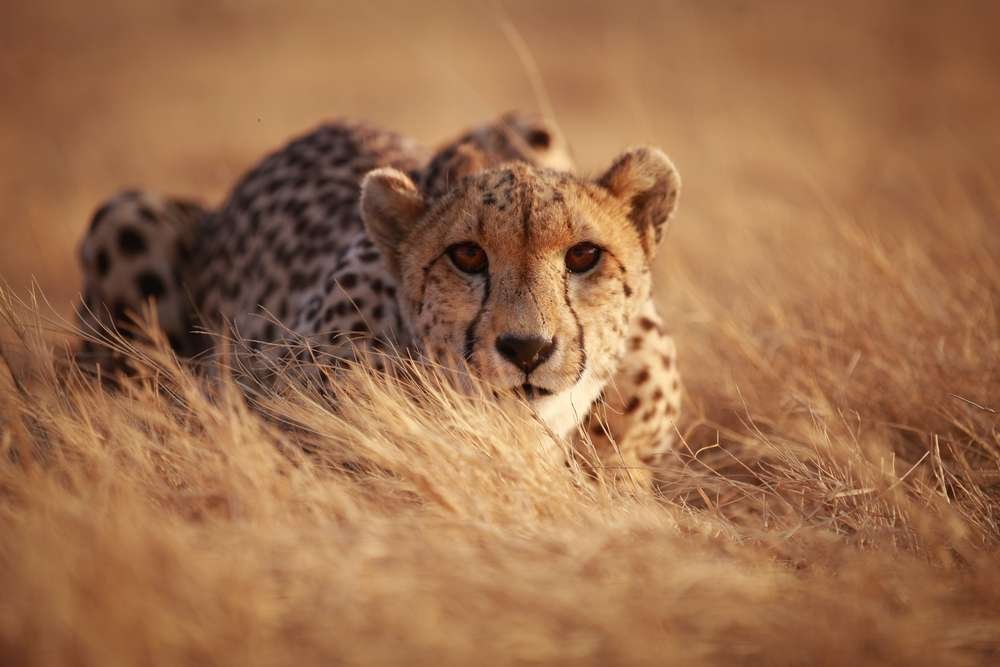Cheetah
( chiseketa )
- Acinonyx jubatus
- IUCN Status: Vulnerable
- Trend: decreasing

- Kingdom: Animalia
- Phylum: Chordata
- Class: Mammalia
- Order: Carnivora
- Suborder: Feliformia
- Family: Felidae
- Subfamily: Felinae
- Genus: Acinonyx
Share:
General Information
Zambia is home to a small but important population of cheetahs. Best places to see them in the wild are in the Kafue, Liuwa Plains and South Luangwa National Parks. They are also a popular attraction at places that offer cheetah walks in many parts of the country.
Fun Facts!
Cheetahs are the fastest land animals on Earth. Cheetah can run up to 120kilometers per hour or 75 mph, reaching top speed in just 3 seconds. At full speed, their stride measures up to seven meters with their feet only touching the ground twice during each stride. They have non-retractable claws that allows them greater grip and traction when running at high speeds.
Description
- Shoulder height: 75 cm
- Length: 112-135 cm
- Weight: 35-65 kg
- Lifespan: 10 years
Ecology and Behaviour
Cheetahs are typically solitary. Females live with their young, whilst males live alone or in ‘coalitions’ with their male siblings. They are not particular social and close contact is limited. They are diurnal, resting in the heat of the day and being active and hunting during the cooler times. This means they avoid competition with larger predators, such as lions, who normally hunt at night.
They are skillful hunters, mainly preying on small antelope as well as smaller mammals and birds. They observe their surroundings from raised areas, such as a termite mound, then will stalk their prey before sprinting in an explosive burst of speed for a short distance, overtaking and taking down their prey. They feed quickly to avoid detection from other larger carnivores and scavengers.
Cheetah are vulnerable to attack from other larger carnivores and cub mortality is very high with about 75% of cubs being killed by lions, hyenas, baboons and leopards.
Conservation
Cheetah are one of the most endangered big cats in Africa. They are classified as Vulnerable on the International Union for the Conservation of Nature (IUCN) Red List.
Distribution and Habitat
Cheetahs have large home ranges depending on the location and movement of their prey. Males are fiercely territorial and scent marking is a main part of their communication. They are also vocal and make a range of bird-like calls which can be heard by other cheetah over 2kms away. They also hiss, growl, snarl and will purr when content.
Females give birth of litters of two to eight cubs after a gestation period of three months. Cubs are born blind and are hidden in dense bushes until a month old and they are weaned at six to eight weeks. They have a ridge of long grey fur running from their neck to tail called a mantle. This is thought to resemble a honey badger and helps them to blend into long grass, keeping them safe from predators.
Cheetah live in open savannah areas, dry scrub areas and open woodlands.
Interaction with humans
Main threats to cheetahs include habitat Loss, the illegal pet trade and poaching and trafficking of skins and body parts, death by vehicles on roads and inbreeding due to low genetic diversity.
No donation to this project yet.
| M | T | W | T | F | S | S |
|---|---|---|---|---|---|---|
| 1 | 2 | 3 | 4 | 5 | 6 | 7 |
| 8 | 9 | 10 | 11 | 12 | 13 | 14 |
| 15 | 16 | 17 | 18 | 19 | 20 | 21 |
| 22 | 23 | 24 | 25 | 26 | 27 | 28 |
| 29 | 30 | 31 | ||||


